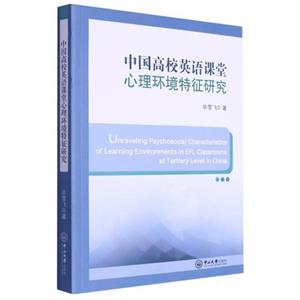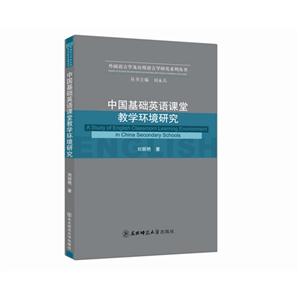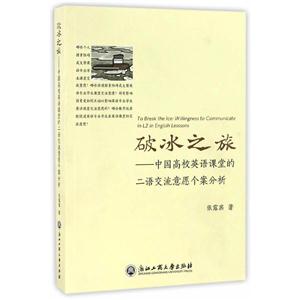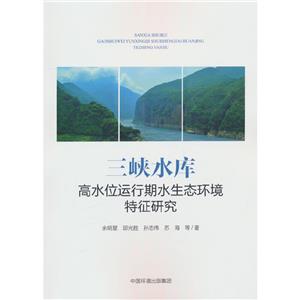
作者:毕雪飞著
页数:10,243页
出版社:中山大学出版社
出版日期:2023
ISBN:9787306078827
电子书格式:pdf/epub/txt
内容简介
本书以作者所在高校为研究对象,通过调查和分析国内高校英语专业师生对英语课堂心理环境的感知状况,全面深入地揭示了中国高校英语课堂学习环境的心理社会特征,阐述了英语课堂心理环境因素同学生英语学习动机的内在关联,探究了中国高等教育背景环境中英语作为外语的大学英语课堂心理环境的特征和本质,对中国高校的英语专业教育具有一定的教学实践指导意义。
作者简介
毕雪飞,女,1982年3月生,吉林东丰人。2013年毕业于中山大学,获英语语言文学博士学位,现任中山大学国际翻译学院英语系讲师。
目录
List of Figures
List of Tables
List of Abbreviations
Chapter 1 Introduction
1.1 Background of the study
1.2 Research aim and objectives
1.3 Significance of the study
1.4 Organization of the book
Chapter 2 Literature Review
2.1 Introduction
2.2 Field of classroom psychosocial environment research
2.2.1 Theoretical basis of classroom psychosocial environment research
2.2.2 Approaches to measuring classroom psychosocial environments
2.2.3 Research involving classroom environment instruments
2.2.4 Research of classroom psychosocial environments in China
2.3 Field of research on motivation in L2 learning
2.3.1 Theoretical models of L2 motivation
2.3.2 Research on L2 motivation
2.4 Summary
Chapter 3 Research Design and Methodology
3.1 Introduction
3.2 Research questions
3.3 Research design
3.4 Subjects
3.5 Instruments
3.5.1 The modified WIHIC
3.5.2 The modified MTCCU
3.6 Data collection procedures
3.7 Data analysis procedures
3.7.1 Procedures for the validation of research instruments
3.7.2 Procedures for the revelation of CE classroom psychosocial environments
3.8 The pilot phase
3.9 Summary
Chapter 4 Validity and Reliability of the Research Instruments
4.1 Introduction
4.2 Validity and reliability of the modified WIHIC
4.2.1 Construct validity of the modified WIHIC
4.2.2 Reliability of the modified WIHIC
4.3 Validity and reliability of the modified MTCCU
4.3.1 Construct validity of the modified MTCCU
4.3.2 Reliability of the modified MTCCU
4.4 Summary
Chapter 5 The Status Quo of CE Classroom Psychosocial Environments
5.1 Introduction
5.2 CE classroom psychosocial environments perceived by students
5.2.1 Actual CE classroom psychosocial environments perceived by students
5.2.2 Preferred CE classroom psychosocial environments perceived by students
5.3 CE classroom psychosocial environments perceived by instructors
5.3.1 Actual CE classroom psychosocial environments perceived by instructors
5.3.2 Preferred CE classroom psychosocial environments perceived by instructors
List of Tables
List of Abbreviations
Chapter 1 Introduction
1.1 Background of the study
1.2 Research aim and objectives
1.3 Significance of the study
1.4 Organization of the book
Chapter 2 Literature Review
2.1 Introduction
2.2 Field of classroom psychosocial environment research
2.2.1 Theoretical basis of classroom psychosocial environment research
2.2.2 Approaches to measuring classroom psychosocial environments
2.2.3 Research involving classroom environment instruments
2.2.4 Research of classroom psychosocial environments in China
2.3 Field of research on motivation in L2 learning
2.3.1 Theoretical models of L2 motivation
2.3.2 Research on L2 motivation
2.4 Summary
Chapter 3 Research Design and Methodology
3.1 Introduction
3.2 Research questions
3.3 Research design
3.4 Subjects
3.5 Instruments
3.5.1 The modified WIHIC
3.5.2 The modified MTCCU
3.6 Data collection procedures
3.7 Data analysis procedures
3.7.1 Procedures for the validation of research instruments
3.7.2 Procedures for the revelation of CE classroom psychosocial environments
3.8 The pilot phase
3.9 Summary
Chapter 4 Validity and Reliability of the Research Instruments
4.1 Introduction
4.2 Validity and reliability of the modified WIHIC
4.2.1 Construct validity of the modified WIHIC
4.2.2 Reliability of the modified WIHIC
4.3 Validity and reliability of the modified MTCCU
4.3.1 Construct validity of the modified MTCCU
4.3.2 Reliability of the modified MTCCU
4.4 Summary
Chapter 5 The Status Quo of CE Classroom Psychosocial Environments
5.1 Introduction
5.2 CE classroom psychosocial environments perceived by students
5.2.1 Actual CE classroom psychosocial environments perceived by students
5.2.2 Preferred CE classroom psychosocial environments perceived by students
5.3 CE classroom psychosocial environments perceived by instructors
5.3.1 Actual CE classroom psychosocial environments perceived by instructors
5.3.2 Preferred CE classroom psychosocial environments perceived by instructors















